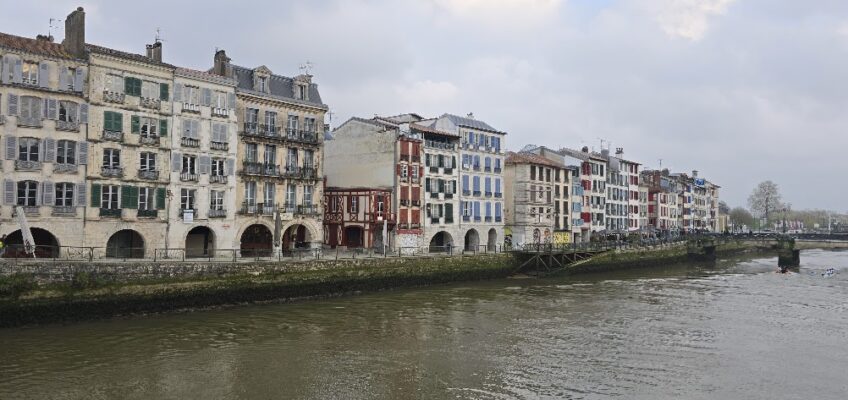In better weather I would have spent at least a good part of the last few days gazing at the Pyrenees as we made our way from Carcassonne to Bayonne, in the heart of the French Basque region. But there was a lot of rain and overcast skies, so we didn’t get to see any snow-covered peaks.
Bayonne was our base for exploring this delightful corner of France. Most of Basque country is in Spain, but a small wedge of southern France, bordered by the Pyrenees and the Atlantic Ocean, is the home to about ten percent of the Basque population.
Auch
On our way to Bayonne, we stopped in Auch. This is not part of the French Basque region, but it’s a cute town with a gorgeous cathedral. (Auch rhymes with gauche.)
For more pictures from Auch, check out my album. For once, I didn’t overdo it. Just a few photos besides the ones above. The stained glass in the cathedral is very impressive, so you should definitely have a look. Included are a few photos from a monument to the Tour de France at a rest area where we stopped a short way past Auch.
Bayonne
I hope it doesn’t get old, but it seems I’m going to be using a lot of screen space to write about how pretty all these towns are. The stunning rows of buildings with their colored shutters and timbered plaster facades along the Nive River and the streets of the old town just make Bayonne a visual delight. (I feel like I used these same words to write about Carcassonne. Bayonne is nothing like Carcassonne, though. This is an actual town where people live. It’s more authentic. That doesn’t make it prettier, but it’s right up there.) The photo at the top of the page should give you a good idea what I’m talking about. Here are a few more.
Chocolate
Bayonne is considered to be France’s chocolate capital. My favorite food came to Bayonne with Portuguese Jews in the 16th century. (Jews were an important part of the community for several centuries after they were expelled from Spain and Portugal.) There are chocolate shops all over town, several on the same street, and in nearby villages as well.
Yes, I did buy some. And yes, I did taste some. And yes, it was wonderful. (I also bought some to bring home, not that Mexico needs a lesson in good chocolate from anywhere else in the world.)
Bayonne Cathedral
Another impressive cathedral! Seems like every town has one!
Fire destroyed an older Romanesque cathedral, and construction of the present structure began in the 13th century. It finished in the 17th century, except for the two spires, which date from the 19th century.
Adjacent to the cathedral is a beautiful cloister, one of the largest Gothic cloisters in France.
Musée Basque et de l’histoire de Bayonne
I wanted to learn a little something about Basque culture, and this museum helped. I didn’t really have enough time to explore the collection in detail, but I enjoyed some of the paintings that depicted Basque life as well as the displays about pelota, the racket sport that spawned jai alai and tennis. And there was some interesting stuff about the history of the Jews in Bayonne and other aspects of life in this region.
Périco Ribera (1867–1949)
Georges Masson (1875–1949)
Our group dropped in and watched a game of pelota here.
Makhilas
We took a short excursion to the nearby village of Larressore, where we visited Makhila Ainciart Bergara, a workshop where they make traditional Basque walking sticks, called makhilas.
The level of workmanship was astonishing. And beyond that, the time it takes to grow the medlar shrubs, dry them, and prepare them is mind-boggling. Each makhila is custom made for its owner. No two are alike. It’s no wonder there is a long wait and a very high price to get one. (They start at 400 euros and go up to 790 euros.)
Espelette
We visited the village of Espelette. This little town’s claim to fame is the Espelette pepper. I didn’t try or buy any, but I saw a lot of them, in some cases hanging out to dry (or maybe just as a decoration).
Espelette also has a pretty church dating to the 17th century.
Biarritz
We stopped in Biarritz after leaving Bayonne, on our way to Bilbao, the next stop on the tour (and where I am now as I write this). We visited the lighthouse there (when I say “visited” I mean saw it) and walked along the beach.
I guess Biarritz is a very upscale beach resort town, and there wasn’t anything particularly Basque to see there. In fact, there wasn’t much to see there at all. It was probably the least interesting place we visited in the French Basque region.
Saint-Jean-de-Luz
Our final stop before crossing into Spain was Saint-Jean-de-Luz. This is a — wait for it — delightfully pretty town. Our first stop was Église Saint-Jean-Baptiste. It was completed in 1685. However, Louis XIV married Maria Theresa here in 1660, when the church was still under construction. There is a plaque on the wall outside the church commemorating their marriage. It’s on the doorway through which the bride and groom entered the church. That doorway was bricked in a few years later when the permanent door was installed.
After visiting the church, we had some free time to walk around and explore this lovely town.
We had lunch in Saint-Jean-de-Luz before climbing back in our van for the final time.
Hola, Spain
Photos
Here are all my photos from the French Basque region. Enjoy!


Leave a Reply